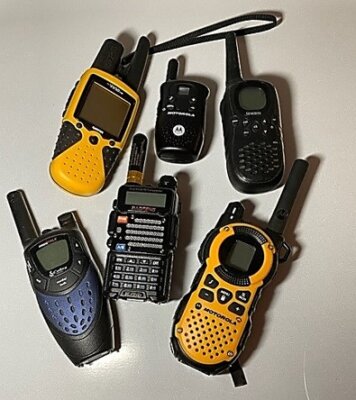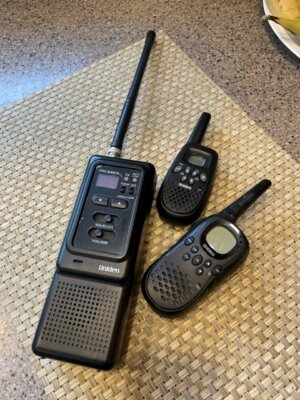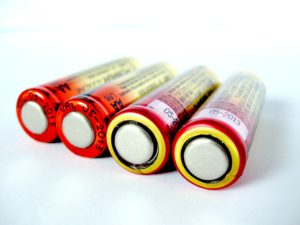I don’t usually jump right into a promotion, but it’s Black Friday and this sale caught my eye! Yes, read this whole Advisory for more on walkie-talkies, but don’t overlook this special:

Why I would recommend this particular Motorola set-up?
- Handy packaging keeps everything together. Easy to wrap as a gift, too!
- Love the fluorescent colors. Most of our radios are black — and tough to find in a lights-out situation!
- Actually water proof, not just water repellent.
- Two-setting flashlight
Click on the image above to see if the Black Friday price is still valid!
Now, back to our regular programming . . .
Our Personal History of Using Hand-Held Radios Continues.


Joe first used hand-held radios in the military when conducting surveillance. In the ’90s, Joe and I used CB radios on sports car rallies before cell phones came into use. And our neighborhood emergency response teams have had walkie-talkies for over 20 years.
All this history has been incorporated into this walkie-talkies review!
First, what makes walkie-talkies so different from cellphones? Simple.
You can share information with your team without having to look up a number, without having to dial, without having to wait to connect. Just push the button and talk! It’s incredibly efficient.
When every other method of communication is down or jammed, a walkie-talkie can be a lifesaver – literally and figuratively. So if you’re considering these handy two-way radios for personal use or for your local Emergency Preparedness teams, here are . . .
Six questions to answer before you buy walkie-talkies.
(You’ll have more, but these will get you started!)
1-How far do you expect to transmit?
Warning: Don’t believe everything you read in sales literature!
Distances claimed by the manufacturers are, at best, estimates! (We picture their testing taking place in a vacuum, with no buildings, trees, traffic, etc.) We look at these specs for comparison purposes, but don’t believe them. When you’re considering simple walkie-talkies, you’re talking about messages traveling from less than a mile to a maximum of 5 miles. Until you’ve tested in your own setting, you just don’t know.
Reach will also depend on what type of radio you get.
FRS (Family Radio Service) radios traditionally operated with a power of ½ watt (500 milliwatts). Since 2017 they’ve been “upgraded” to being able to operate at 2 watts. They work well for local transmissions and if you are starting your research, this is the place to do it!
GMRS (General Mobile Radio Service) devices can transmit at higher power levels (1 to 5 watts is typical). Add an external antenna and you may be able to expand your reach by as much as five times. You’ll need a license from the FCC to operate your GMRS device. New rules as of April, 2022: License fee down from $70 to $35, covers the whole family, and is good for 10 years!
Many existing radios combine both FRS and GMRS. It was my understanding that these hybrid radios were going to be phased out, but there are still many available and they all work just fine.
Tip: If there’s a question about distances, buy ONE pair of radios and test in your own setting before you invest in multiples.
And another tip: Two years ago our neighborhood was threatened with evacuation due to high winds driving a wildfire right towards us. Everybody in the entire community was on every conceivable communications device . . . and our FRS channels were overloaded! We were disappointed. But we assumed that after the initial overwhelm, the air would clear out. And so it did.
Alert: If you think you need to be able to communicate from anywhere, then you need more than a walkie-talkie. Jump to our latest review, below, on satellite phones for emergency.
2-How many channels do you really need?
There are 22 mobile radio channels. In our neighborhood, we have assigned different channels to different streets. Everyone on our street, for example, turns to Channel 5 to communicate. A business might want to assign different channels to different business FUNCTIONS on the business campus. In any case, think about how you will set up your communications protocols before you make a final decision on how many channels you need. (Want ideas for how to set up a local communications matrix? Request a copy of our neighborhood radio channels matrix here.)
Since the FCC made changes in 2017, the 22 channels are shared. It’s a little confusing. FRS radios can use their 2 watt power on all channels except 8-14, where they have to power down to .5 Watt. Under the current rules, GMRS has to use .5 Watts on these channels, too but can power up to 5 Watts on 1-7 and up to 50 Watts on 15-22.
If you absolutely need more information about the FCC changes, here is a reference that may be useful. https://wiki.radioreference.com/index.php/FRS/GMRS_combined_channel_chart
Warning #1: New low-cost walkie-talkies are available that can access many more than the standard 22 channels. However, many of these channels are restricted to official use, so purchasers of these radios may be buying more than they can actually use. And they must program their radios to be sure they use only the allowed channels. Be sure you know what you are buying.
3-How handy are your users?
Like other electronic gadgets, the smaller the device, the more functions each button has. My grandchildren figured everything out within minutes, but for “more mature” team members, slightly larger radios are a heck of a lot easier to use. In particular, we look for an obvious on-off switch, easy-to-adjust volume and channels, an easy-to-open battery compartment, and a sturdy case.
Users will need SOME training. And remember, in an emergency, everything will become much more difficult! (I’ve reported before about our neighbor whose house caught fire. She was unable to call 911 because she kept dropping her phone!) Be sure to repeat training on a regular basis to be sure users are up to speed and batteries still work.
4-What kinds of batteries do you need?
As you can imagine, radios come with a variety of power options. Some offer disposable, regular alkaline batteries, either AA or AAA. Some have rechargeable batteries and come with a plug-in charger stand. Some offer both options.

We prefer regular batteries over rechargeable batteries for emergency radios. In a real emergency, there will be no power, so as soon as the rechargeable battery is exhausted, you’re out of luck (unless you have a power bank or solar charger).
We have conducted repeated tests regarding alkaline battery reliability and life. An early test put Duracell at the top of the list. Two years later, we found that Eveready batteries outperformed both Duracell and Costco’s proprietary brand. Recently we tested another private label and found no real difference between it and the brand names.
So, we recommend that you look for convenience and cost when purchasing batteries. Amazon has its own brand now, too – you can assume rapid turnover of that inventory and thus you’re probably getting a “fresher” battery.
Caution: A battery may be labeled as having a “Ten Year Life,” but if it’s already 2 years old when you take it off the shelf . . .!!
New battery technology appears all the time; you may want to do your own tests.
5-Are your radios compatible with one another?
We all heard how police and fire departments couldn’t communicate during 9/11 because their emergency radios operated on different frequencies. Today, they’ve made progress but some even well-known radio brands still do not necessarily “talk” to others. If you’re outfitting a number of citizen teams with standard, inexpensive walkie-talkies, or replacing outdated devices, they will very probably work together. But check to be sure!
6-What sort of warranty comes with the radios?
We have had good luck with our radios right out of the box. But every legitimate manufacturer will offer some sort of warranty. Check to be sure you know its features.
Some of the hand-held radios we’ve used and/or tested
These models have been reviewed and updated most recently as of January, 2023. If you click on the image or the link, you’ll go directly to Amazon, where you can check the current price and continue shopping. If you purchase through Amazon, EmergencyPlanGuide.org may get a small commission. (They call it an Advertising Fee.) It doesn’t affect how much you pay.
In case you’ve noticed, we continue to recommend that you start your shopping at Amazon. We find it consistently has the best selection and good prices, and the customer reviews are particularly helpful. But do take the time to shop. At the most recent update of this page, I found prices for the SAME radio varying by as much as $16!

Great starter radio
Here is a radio that is small, but not TOO small. It has only the basic 16 channels, but it does add a flashlight as an extra. I like the physical on-off switch.
Note that this walkie-talkie operates only with rechargeable batteries, so keep that in mind if you are looking for a radio for emergency use. In a real emergency you don’t want to run out of power, so having a radio that operates on regular batteries may be a better choice.
Bigger and tougher
I like the feel of this Motorola, and with a colorful face it’s a lot easier to keep track of than an all-black radio!
With a bigger price tag, you get more: twice the range (theoretically – Go back and read the comments about RANGE!) good weatherproofing, and NOAA weather channels. It also has an emergency light.
This radio operates on a rechargeable NiMH battery or with AA batteries.

Still more user options
We have owned and used a series of Midland walkie-talkies and found them reliable and well made.
This “package” offers more channels, a longer range (remember our cautions), several emergency/safety features, and multiple options for charging. It even boasts a degree of hands-free operation.
Shop carefully, because there are packages with different color schemes and extra features that may be more of what you want!

A popular model for more skilled operators
Many of the CERT groups we know, and also many ham radio operators, have been attracted by the series of two-way radios manufactured by BaoFeng.
We own a couple of BaoFeng walkie-talkies. Prices continue to go down as new generations of the radio come onto the market. This picture shows the 3rd generation of the F8HP. It comes with a whole collection of extras: a heavy-duty battery, V-85 dual band antenna, charger, 110V Adapter, earpiece kit, wrist strap, belt clip, user manual. Using these radios requires that you make a lot of decisions about options. We are using “Programming Amateur Radios with CHIRP,” by Brian Schell, to help us do our own programming. BaoFeng radios are for competent, not casual, users.
Satellite phones for emergency
Last year we added another section to our walkie-talkie reviews — thanks in part to questions from one of our readers who was looking for the ultimate in emergency communications. That is, he wants to be able to communicate with other family members in the case of a wide-spread and disastrous earthquake. We can assume all landline and cellphones will be down and HAM frequencies may be overloaded.
We exchanged several emails and I am sharing what I learned. Some very simplified highlights:
- Satellite phones have been widely used by governments, energy companies, and shipping companies. These days, hikers and explorers, as well as search and rescue teams, carry them as insurance.
- Phone signals from satellite phones travel through the air, just like other walkie-talkies, but they don’t connect directly. Rather, they bounce off — you guessed it! — satellites. Satellites aren’t affected by earthquakes so theoretically, your signal will get through as long as your phone can “see” the satellite. (Signals can be affected by buildings, trees, etc. that block the sky. ) Some satellites travel around the earth, others are stationary. Your choice of phone determines which type of satellite you get.
- Simple satellite phones transmit text messages. These phones start at around $300 each. A phone that can transmit voice messages costs about twice as much.
- Satellite phones also require that you pay for service, either on a pre-paid by-the-unit basis or with a monthly always-on subscription.
Two popular satellite phones for comparison
The no-frills Garmin inReach Mini is small, compact, easy to pack and carry for hikers. It weighs only 3 oz. and is only 4 in. tall and 1 in. thick. It enables 2-way text messaging, and also has an SOS function plus optional weather forecasts. Click the link below to go to Amazon to get the full description and current price.

Our second example is the Inmarsat Isatphone 2.1. This phone has truly global reach — without roaming charges! As you can see, it’s considerably larger than the Mini shown above. In fact, it is about 3 times larger and weighs 8 oz. more. The picture shows the phone and also some of the additional accessories that are available, in particular Bluetooth and WiFi connection capabilities. The complete list includes various charging adaptors, wired headset, lanyard strap, and more.

As always, be aware that electronic equipment — not to mention utility services! — change on a regular basis. Be sure you are getting what you THINK you are getting, and take note of warranties and refund policies.
One last request –– please write to us about your own experiences with walkie-talkies under real-life conditions. Every bit of information helps when people are looking for just the right emergency equipment. Thanks!


I am considering walkie talkies fir my 2 grandchildren who live less than 5 miles from me for a emergency .quite frankly with the amount of severe changes and violence in our country I want to be able to get to them have them know I’m coming or guide them without them being seen from their hoyse to mine.
Hi, Pamela. I like the idea. Let me ask, how old are your grandchildren? And how good is the cellphone coverage where you live? Because I work as a crossing guard at an elementary school, I see children every day using “smart watches” to check in with parents, both when they arrive at school and then again when they set off for home. Everyone I’ve asked seems to find this technology acceptable. Of course, in a big emergency, the cell towers may be down or overwhelmed. In that case, a GOOD set of walkie-talkies could allow you and the grandchildren to talk to each other. Five miles is at the maximum reach of most walkie-talkies, of course. And since they depend on line of sight, you’d want to know what obstructions are in the way between your home and the kids. But I’d consider buying a pair of the walkie-talkies, and testing! Let us know.